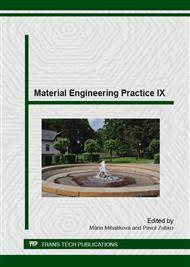p.1
p.5
p.9
p.13
p.18
p.22
p.26
p.30
Changes of Mechanical Properties of AlSi7Mg0.3 Cast Alloy through Filtration
Abstract:
Molten aluminium alloy is so active that it an easily chemically react with O2 and H2O to form Al2O3 inclusions and H during melting practice. However, some other inclusions form by process. Under turbulent flow conditions, the inclusions are distributed unevenly in molten aluminium alloy. They may associate with crack or by the location of crack initiation in solidified casting. Castings containing these inclusions will probably exhibit poor ductility or toughness. Therefore, the purification of the molten aluminium alloy is one of the most important processes for improving the quality of Al-products. The inclusions in molten secondary AlSi7Mg0.3 cast alloy (without refining or modification; grain refined with 55 ppm AlTi5B1 and modified with 20, 40 and 60 ppm AlSr10) were removed using depth filtration by ceramic foam and pressed filter. The results showed that the mechanical properties through filtration changes. Ductility and UTS of the filtered tensile specimens increases. The better mechanical properties were measured by the using of pressed ceramic filter. Highest UTS and ductility was observed for samples modified with 40 ppm of Sr. Filtration with ceramic filters have very significant influence on the porosity decreasing; in the process the better effect has a pressed filter. In samples modified with 60 ppm of Sr were observed effect of over modification (mechanical properties decreased; porosity increased).
Info:
Periodical:
Pages:
1-4
Citation:
Online since:
December 2014
Authors:
Keywords:
Price:
Сopyright:
© 2015 Trans Tech Publications Ltd. All Rights Reserved
Share:
Citation:


